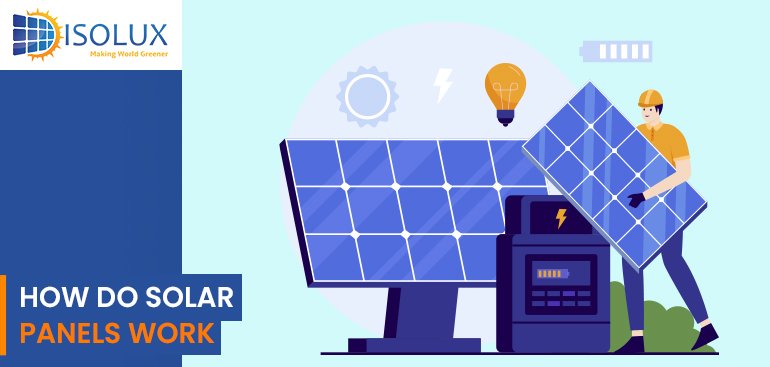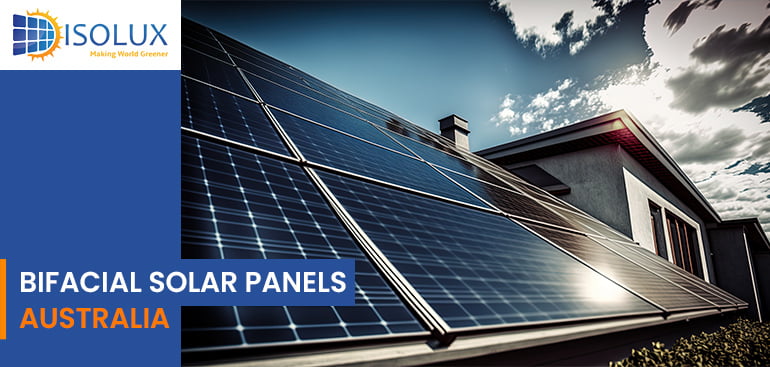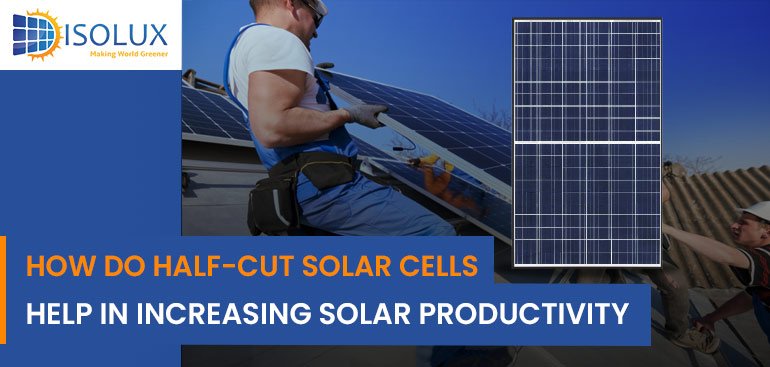Solar panels capture sunlight and convert it into electricity. Imagine them as super-efficient light catchers on your roof. When sunlight hits these panels, it triggers a reaction that generates electrical power. This clean and green energy helps the environment but, also puts you in control of managing and saving your energy bills. So, if you’re thinking about going solar, it’s like having your power plant on the roof, turning sunlight into energy for your home. Know how solar panels work.
Step by Step Guide: How Solar Panels Work
Solar panels work by harnessing the energy from the sun to generate electricity. They do this through a process called the photovoltaic effect.
1. Solar Cells
The basic building block of a solar panel is the solar cell, also known as a photovoltaic cell. These cells are made from silicon, a semiconductor material. Silicon absorbs photons of light and converts them into electricity.
2. Absorption of Sunlight
When sunlight hits the solar panels, the photons (particles of light) are absorbed by the silicon cells. This energy absorption causes the electrons in the silicon.
3. Generation of Electrical Current
The movement of these energized electrons creates an electrical current, which we call electricity.
4. P-N Junction
Solar cells are designed with a P-N junction. This junction is the boundary between two different layers of silicon. The P-layer has a surplus of positively charged holes, while the N-layer has excess negatively charged electrons. When sunlight is absorbed, it helps create an electric field at this junction, which drives the movement of electrons.
5. Direct Current (DC) Output
The electricity generated by the solar cells is in the form of direct current (DC), which is a constant flow of electrons in one direction. However, all the household appliance works on alternating current (AC). To make the electricity generated by the solar panels compatible, it needs to be converted from DC to AC. This is typically done using an inverter, which changes the direction of the electric current. The converted AC electricity is then distributed to power homes, and businesses, or can be fed into the electrical grid.
6. Connection to the Grid or Battery
The converted AC electricity can then be used to power your home or business. If your solar panel system generates more electricity than you consume, the excess can be sent back to the electrical grid if your system is grid-tied. Alternatively, it can be stored in batteries for later use if you have an energy storage system.
7. Monitoring and Maintenance
Solar panels are usually set up with monitoring systems to keep track of their performance. Regular maintenance, such as cleaning and ensuring the system is free from shading or damage, helps maximize their efficiency and lifespan.
Components of a Solar Panel System
A typical solar panel system consists of the following key components:
1. Solar Panels
1. Solar panels capture sunlight and convert it into direct current (DC) electricity.
2. Panels are made up of photovoltaic (PV) cells, which use a semiconductor material like silicon to generate electricity.
2. Inverter
The inverter converts DC electricity from the panels into alternating current (AC), which is used by most household appliances.
Types of inverters include string inverters, microinverters, and hybrid inverters.
3. Solar Mounting System
This secures the solar panels to your roof or the ground, ensuring optimal exposure to sunlight.
4. Battery Storage (Optional)
A solar battery stores excess electricity for use during cloudy days or at night.
5. Electricity Meter
Tracks electricity production and consumption, essential for monitoring system performance.
6. Grid Connection (Optional)
If connected to the grid, you can export surplus energy and earn credits via feed-in tariffs.
Types of Solar Panels
1. Monocrystalline: Made from a single continuous silicon crystal, they are more efficient, space-efficient, and expensive.
2. Polycrystalline: Made from silicon crystals melted together, they are less efficient than monocrystalline panels but are more affordable.
3. Thin-Film: Made by placing one or more layers of photovoltaic material on a substrate, these are flexible and lightweight but generally less efficient.
Also read: Guide to Different Types of Solar Panels
Difference Between Solar PV Panels and Solar Thermal Panels?
Solar PV panels and solar thermal panels might both harness the power of the sun, but they do different things. Solar PV panels work like magic to generate electricity by using the photovoltaic effect. This involves photons from the sun hitting a semiconductor surface, causing the release of electrons and the creation of electrical energy.
On the other hand, solar thermal panels are a bit more straightforward. They directly heat water or other fluids using sunlight. In homes, solar thermal panels are often set up on sun-facing roofs, and warming water is stored in a cylinder for household use. On a grander scale, solar thermal can even be employed in power stations. So, whether it’s electricity or a toasty shower you’re after, there’s a solar solution for you!
How Do Heat and Light Affect Solar Panels?
Australian summers are renowned for their abundant sunlight, a boon for solar panels. However, too much light can bring the challenge of excessive heat, potentially lowering the efficiency of solar panels. To ensure your solar panels endure the conditions, it’s crucial to have a well-engineered solar panel from a reliable supplier, designed to thrive in Australian climates. As long as your solar panels receive sufficient light, you can trust them to perform efficiently.
Do Solar Panels Work on Rainy Days?
Rainy days often bring a gray hue to the skies, prompting questions about Do solar panels work on rainy days. Contrary to common belief, solar panels do not throw in the towel when raindrops start to fall. We acknowledge that while their performance may see a slight dip, solar panels can still generate power during rainy weather. The key lies in their ability to capture diffused sunlight, showcasing the adaptability and resilience of these technological marvels.
Do Solar Panels Work in Winter?
As winter descends and blankets the world in cooler temperatures, there may be concerns about how solar panels perform in Australia’s winter season. Rest assured, solar panels don’t hibernate during the winter months; in fact, they often thrive in colder weather. Surprisingly, solar panels tend to operate more efficiently in cooler temperatures.
Do Solar Panels Work at Night?
The allure of solar panels extends beyond daylight hours, prompting the question—do solar panels work at night? We demystify this common misconception by stating that solar panels are, indeed, inactive during the night. However, the innovative integration of energy storage solutions, such as batteries, allows for the retention of surplus energy generated during the day. This stored energy serves as a reliable power source when the sun takes its nightly hiatus.
Do Solar Panels Work on Cloudy Days?
Cloudy days cast shadows of doubt on the working of solar panels, but fear not—we unravel the truth. Solar panels generate power even under cloud cover. While the energy output may experience a reduction, it’s crucial to note that solar panels can still harness energy during cloudy days. Modern advancements, such as bifacial solar panels, further enhance their performance by capturing reflected sunlight from cloud cover, ensuring a steady power supply.
When Was Solar Power Discovered?
Humans started tapping into solar power in the 7th century B.C. by using sunlight to light fires. The Greeks and Romans joined in around the 3rd century B.C., using mirrors to shine sunlight and light up torches for their ceremonies.
Fast forward to 1839, a French physicist named Edmond Becquerel discovered the photovoltaic effect essentially turning light into electricity. Then, in 1954, the first practical solar cell was born thanks to Daryl Chapin, Calvin Fuller, and Gerald Pearson at Bell Labs. This cell could convert sunlight into enough power to run everyday electrical devices.
Conclusion
Embracing the solar revolution is not just about adopting a new energy source; it’s a commitment to a sustainable and brighter future. As solar power continues to evolve, it illuminates our path toward a cleaner, greener, and more energy-efficient world.
Install solar panel system from a local solar installer in Sydney.
Get a no-obligation free quote from Isolux Solar now.




